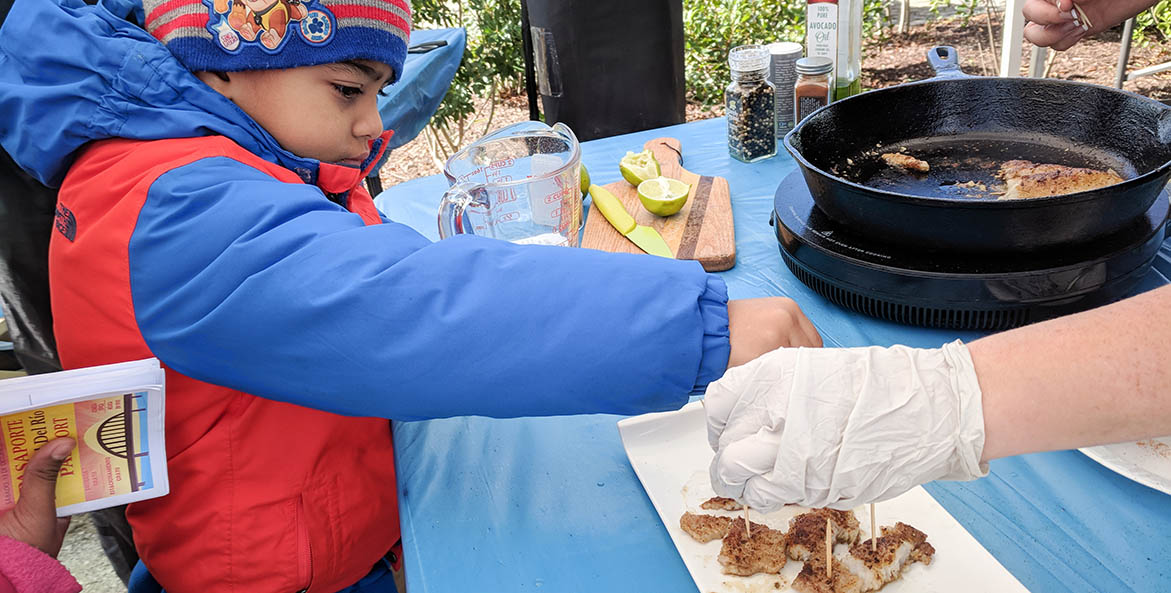For the last five years, the Festival del Rio Anacostia has welcomed Latino families to the Bladensburg, Maryland, waterfront to celebrate their culture and the river in their midst. One popular exhibit is a cooking demonstration that shows festival-goers who fish from the Anacostia how to safely prepare and eat their catch.
Maryland and Washington, D.C., where the river makes its 8.5-mile journey to the Potomac, advise against eating—or limiting consumption of—several fish species, including brown bullhead catfish, blue catfish, channel catfish, carp, eel, and largemouth and smallmouth bass.
Yet many Spanish-speaking anglers who feed their families from the river aren't aware of the dangers posed by polychlorinated biphenyls (PCBs), mercury, and other toxics that pollute its waters and accumulate in the fatty tissue of bottom-dwelling and carnivorous fish.
"People need to know first, that it is not safe to eat the fish. But if they eat it because they need to, they learn at this festival how to prepare the fish in a safe manner," said Ruby Stemmle, Founder and CEO of ecoLatinos, a nonprofit that engages Spanish-speaking communities to be good stewards of the Chesapeake Bay and its waterways.
The demonstration and illustrated companion poster that provide this valuable information are the work of the federal Chesapeake Bay Program. Outreach Coordinator Caitlyn Johnstone filleted, cooked, and offered samples of catfish (from the District's Ivy City Smokehouse, not the Anacostia) in 2018 and 2019. Bilingual student volunteers were on hand to translate.
Johnstone and Hugo Bonilla, chef and owner of Riviera Tapas Bar in Riverdale, Maryland, filmed a video version with Spanish subtitles for last year's pandemic-friendly online festivities.
Johnstone stresses removing the skin and fat of the fish, where toxics concentrate, and discarding used cooking oil, which may contain contaminated drippings. Stemmle, a member of the Chesapeake Bay Program's diversity workgroup, said the exhibit is successful because it delivers a simplified, visual message, directly to the community in a relaxed, social setting.
Reaching across language and cultural differences takes more than just translating materials from English to Spanish, Stemmle said. It requires "applying cultural competence."
"It takes more than just translating a website or a flyer," Stemmle added. "We're not talking to machines, we're talking to people. You need to meet people where they are and build relationships and trust."
The festival is held every fall to coincide with National Hispanic Heritage Month (September 15 through October 15). This year, it is scheduled for October 9.
Concerns about the presence of toxic chemicals in finfish and shellfish exist across the U.S. For more information about current fish consumption advisories for the Potomac and other local Chesapeake watershed waterways, please visit the following websites:
- D.C. Department of Energy & Environment Fishing in the District
- Delaware Department of Natural Resources Fish Consumption Advisories
- Maryland Department of the Environment Fish Consumption Advisory
- New York Department of Health Advice on Eating Fish You Catch
- Pennsylvania Department of Environmental Protection Fish Consumption
- Virginia Department of Health Fish Consumption Advisory
- West Virginia Department of Health & Human Services Sportfish Consumption Advisories

Washington, D.C. Communications & Media Relations Manager, CBF
[email protected]
202-793-4485
Issues in this Post
Fisheries Community Fishing Food and Drink Runoff Pollution Water Quality



